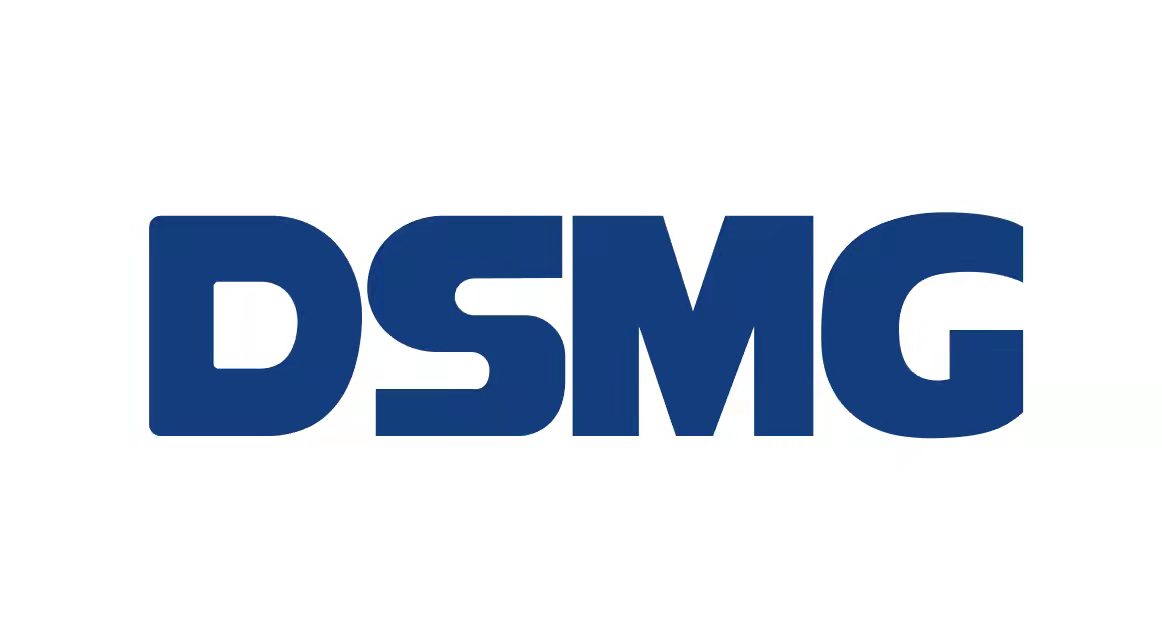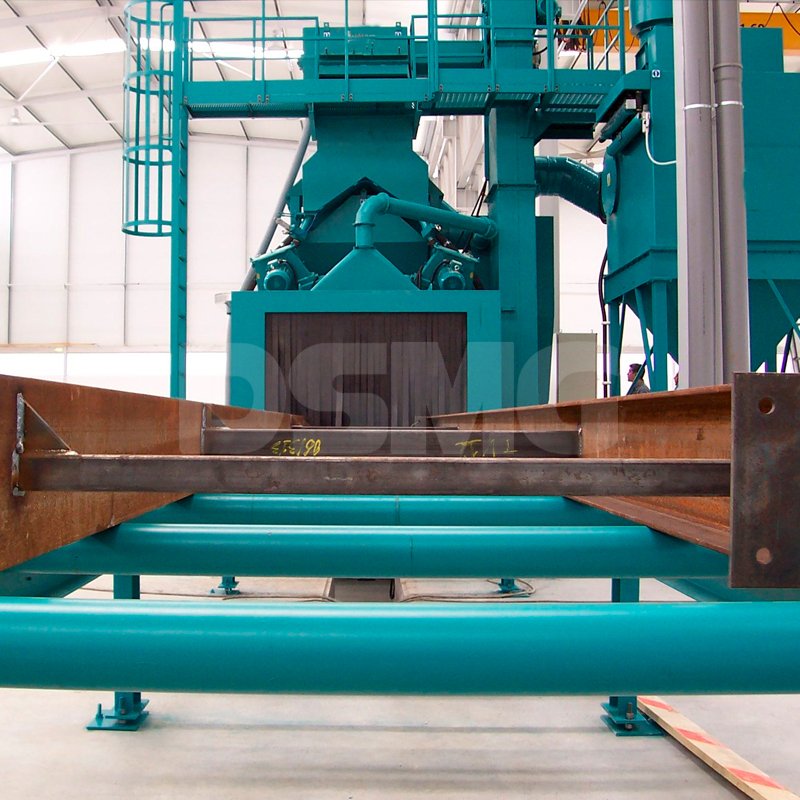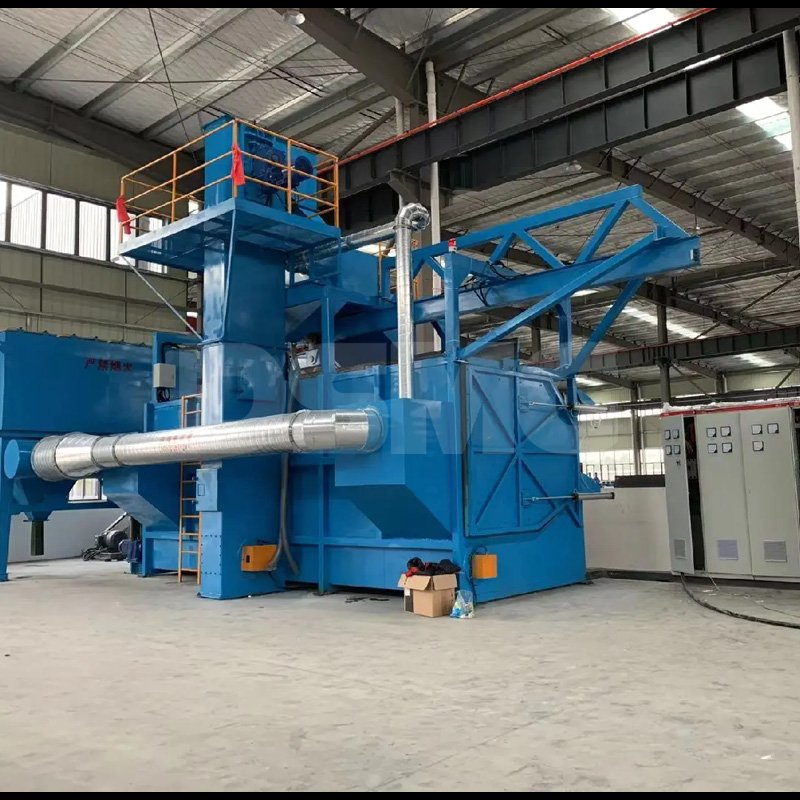Tumblast Machine consist of Cabinet equipped with Steel Belt Conveyor System. The components are loaded through Mechanical Loader or Manually into Steel Belt of the Machine. The door is closed and machine is started, due to endless movement of belt, the components tumble gently and are also exposed to shot blast stream for shot blasting purpose. The advantage of this machine is that all faces of components are thoroughly cleaned in the machine due to tumbling action, after blasting the door is opened and the movement of conveyor belt is reversed so that all components are taken out from the belt on User's Trolley.



Shot Blasting Tumblast Machine, a alloy metal Conveyor Chain is provided. This advantages of Chain Conveyor lies in loner life, better tumbling action, no sagging of coneyor, no frequent tightening of Conveyor of required. You need to replace only worn out Mettalic Strips (no need to replace whole Conveyor). This Machine is recommeded for cleaning of medium to heavy casting
The Blast cabinet is fabricated from 8-10 mm thick heavy duty prime quality steel plates, supported by strong rolled structure welded construction and engineered suitably for strength and rigidity to guarantee the optimum sturdiness. This robust rolled structure with thick plate foundation holds stand the machine and helps to reduce vibration keep within permissible limits. The blast cabinet bottom is provided with mild steel perforated floor for protection against abrasion wear. In the standard machine cabinet is lined with highly abrasion resistant special grade rubber sheet having thickness 6 mm. The rubber sheet has special property to retard abrasion on account of rebouncing of abrasive. The direct blast zone of the cabinet is provided with 12 mm thick work hardening grade Mn. Steel circular liners (left and right). A horizontal / Vertical door is provided having limit switch for safety purpose. Inside of door is fully lined with tyre grade rubber liner. The door is fitted with limit switch and lever type lock is provided for locking the door and preventing escape of abrasive.In case Mn. Steel Lining inside the cabinet (Optional accessory) is ordered then the entire cabinet is lined with long life Mn. Rolled steel sheet.


Q1: What is tumble belt shot blasting machine?
A: Tumble belt shot blasting machine is equipment that uses high-velocity abrasive projection to clean and strengthen workpiece surfaces. Its core mechanism relies on centrifugal force to propel shot media (e.g., steel grit) onto substrates. A rotating belt (composed of linked plates) continuously tumbles workpieces, exposing all surfaces uniformly to the abrasive stream. This process is ideal for deburring, descaling, rust removal, and surface preparation.
Q2:What are the main application scenarios of the tumble belt shot blasting machine?
A:It is mainly applied in heavy industrial fields such as foundries and forging plants, and is particularly suitable for handling the following scenarios:
Mass production of parts: such as castings and forgings;
Workpieces with sharp edges or complex shapes;
Components that need to complete surface cleaning (removing scale and rust layers) or surface strengthening (improving fatigue life).
These machines are also suitable for the processing of light alloy parts.
Sand removal, core iron removal, bronze and light metal castings
Rust removal of forged metal components and components that have undergone heat treatment
Deburring of metal and non-metal parts
Forced but gentle turning and tumbling of parts with all-round impact
High-performance shot peening for specific applications
Continuous and thorough shot blasting for rust removal
Q3:How does the belt structure of the tumble belt shot blasting machine ensure stability and durability?
A:The belt achieves high durability through the following structure:
Belt plates and chain links: Fixed by bolts, and the connecting elements are made of wear-resistant materials (such as manganese steel) to resist the impact of shot blasting;
Forward rotation design: Ensures that the workpieces tumble evenly and will not accumulate;
Modular design: Facilitates local replacement (such as severely worn belt plates) and reduces maintenance costs.
Q4:How is the automated loading and unloading process of the equipment achieved?
A:In the automatic mode, the loading and unloading are completed through the following steps:
Loading: Use a feeder (such as a bucket elevator), a container or a tray to load the workpieces, and slide them into the running belt from the loading door;
Unloading: After the shot blasting is completed, the belt rotates in the reverse direction, and the workpieces are discharged through the inclined unloading chute (which can directly fall into the customer's container);
No manual intervention is required throughout the process, and the door control system is linked and locked to ensure safety.
Q5:How are the abrasives during the shot blasting process treated and recycled?
A:The abrasive recycling system includes the following key links:
Recovery and cleaning: Separate waste materials (such as scale and debris) through gravity screening and magnetic separation devices, and the cleaned abrasives enter the storage bin;
Quantitative feeding: Use the shot blasting medium quantitative device to convey the abrasives to the shot blaster as needed;
Shot blaster: The high-performance turbine accelerates and shoots the abrasives, forming a closed loop of recycling, reducing losses and saving costs.
How to ensure a dust-free environment during the operation of the tumble belt shot blasting machine?
The equipment achieves environmentally friendly operation through the following measures:
Negative pressure system: The fan generates negative pressure to prevent dust from spilling out;
Multi-stage filtration:
Primary separator: Removes large-particle dust;
High-efficiency bag dust collector: Filters fine particles (dust removal efficiency > 99%);
The purified air can be discharged in compliance with regulations and meets industrial environmental protection standards.
Q6:What key points of safety control should be paid attention to in the operation process?
A:The key safety controls include:
Door lock linkage mechanism: The door is automatically locked during shot blasting to prevent accidental opening;
Emergency stop device: Can stop the machine immediately in case of a sudden failure;
Vibration and noise control: The equipment design needs to meet the ISO vibration standard (such as < 85dB);
Regular maintenance: Check the wear of the belt, the blockage of the dust removal system and the change of the abrasive particle size.
Q7:What is the impact of parameter adjustment of the tumble belt shot blasting machine on the process effect?
A:The adjustment range and impact of the core parameters are as follows:
Shot blasting time: Too short will lead to incomplete treatment, and too long may damage the workpieces;
Shot blasting speed (adjusted by adjusting the turbine speed): High speed is suitable for hard materials (such as cast steel), and low speed is suitable for thin-walled parts;
Abrasive type and particle size: Steel shot (for general cleaning), stainless steel shot (for high surface finish requirements), and the selection of particle size needs to match the target surface roughness.
Q8:Compared with other shot blasting machines, what are the advantages of the tumble belt equipment?
A:Its main advantages include:
High processing efficiency: Continuous cyclic operation, suitable for mass production;
Uniformity: The belt tumbling ensures full surface coverage;
Energy conservation and environmental protection: The abrasive recycling and dust removal system reduces resource consumption;
Flexibility: Compatible with various workpiece sizes, and the modular design is convenient for expansion.
What technical parameters should be focused on when selecting the equipment?
The following parameters need to be comprehensively evaluated when selecting the equipment:
Workpiece size range (maximum/minimum size and weight);
Belt load capacity (processing capacity per unit time);
Turbine power and shot blasting quantity (kg/min);
Air volume of the dust removal system (m³/h);
Energy consumption and floor space: Adapt to the conditions of the factory building and the budget.
 中文版
中文版











